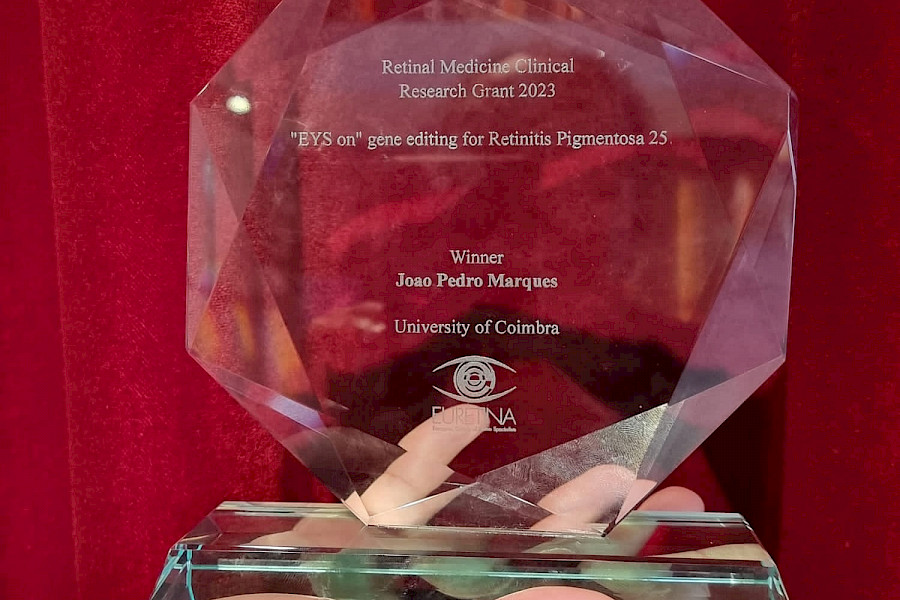iCBR-FMUC receives 300,000 euros for research into hereditary retinal dystrophies
This is the highest amount ever awarded in the five editions of EURETINA - European Society of Retina Specialists.
João Pedro Marques (on the right), receives the 2023 EURETINA Retinal Medicine Clinical Research Award
© DR
Translation: Diana Taborda
Researchers from the Coimbra Institute for Clinical and Biomedical Research (iCBR) of the Faculty of Medicine, University of Coimbra (FMUC) have been awarded 300,000 euros to develop a treatment for an inherited retinal disorder (IRD). The amount is the highest ever awarded in the five editions of EURETINA - European Society of Retina Specialists grant.
João Pedro Marques (Principal Investigator) and Henrique Alves (Co-Principal Investigator) are the leaders of the 'EYS on gene editing for retinitis pigmentosa 25' project, which received an award at the 23rd EURETINA Congress held in Amsterdam this year. The team also includes Francisco Ambrósio (coordinating researcher) and Peter Quinn, researcher at Columbia University (USA), one of the world's top 20 institutions in the field of ophthalmology.
The Principal Investigator (PI) claims that "ophthalmology research in Portugal is among the best in the world, as evidenced by the fact that Portuguese ophthalmologists, especially from Coimbra, have received three EURETINA grants". Of the five editions of the Retinal Medicine Research Funding Grant - which supports independent clinical research in the field of retinal medicine - this is the third time it has been awarded to research teams from Coimbra, this year with the largest amount ever granted. In 2020 and 2022, funding was granted to projects addressing age-related macular degeneration.
The winning project focuses on pigmentary retinopathy, a rare, chronic genetic disorder that affects the retina, the light-sensitive tissue at the back of the eye. The progressive disease can be caused by more than 80 genes and leads to a gradual loss of vision, starting with reduced night vision (nyctalopia) and loss of peripheral vision. There is currently no cure for pigmentary retinopathy and it is estimated that around 2,600 people in Portugal alone are affected by this condition. The research team used the national web-based registry for inherited retinal dystrophies (IRDs) and concluded that the EYS gene is the main cause of the disease in Portugal. The researchers carried out a natural history study of EYS patients followed in Coimbra to identify the most common mutations in the Portuguese population and to understand the progression of the disease over time.
Finding a treatment for "a highly prevalent mutation in the group of patients studied in Coimbra" was one of the driving forces behind this research. In one of the 'Talking (EU) Retina' podcast episodes, João Pedro Marques explains that the value of the EURETINA grant, together with previously secured funding, will allow them to afford cutting-edge technology to carry out the research. The PI and ophthalmologist adds: "We want to provide a solution for patients, including many Portuguese patients, who suffer from this disease and who will go blind without treatment".
The research uses Prime Editing, an "in situ and in vivo" genome editing technology, that allows for precise and targeted changes to the genetic material in a patient's cells. Henrique Alves explains that this is "the most advanced and safest genome editing technique available today" because it minimises off-target effects, thereby increasing safety and accuracy.
The ability to 'replace a single DNA base with another' is a key advantage of prime editing and a major step towards the development of new treatments for various causes of inherited blindness.
The challenging two-year work plan includes the recruitment of two researchers and will take off in April 2024. The iCBR-FMUC researchers hope to attract "young researchers, Masters students or future PhD students interested in pursuing a career in the study of inherited retinal disorders".


